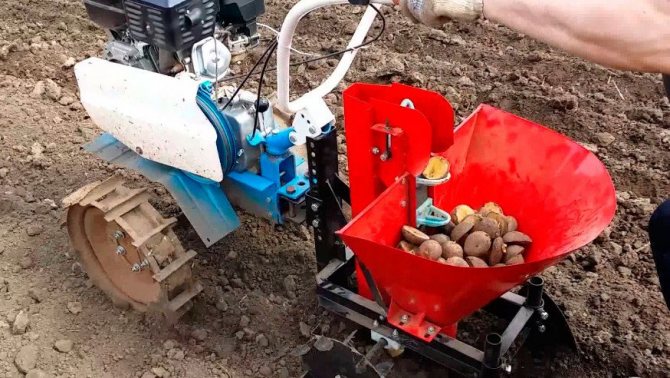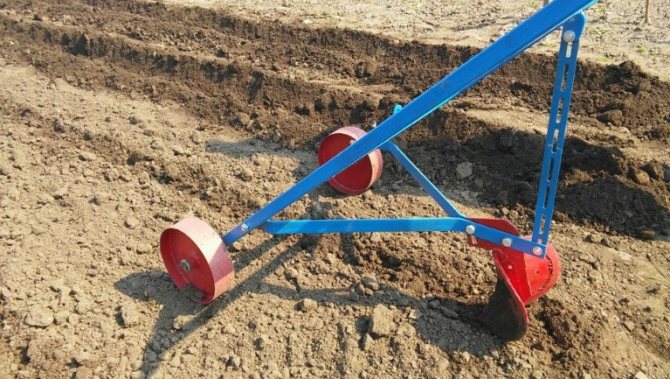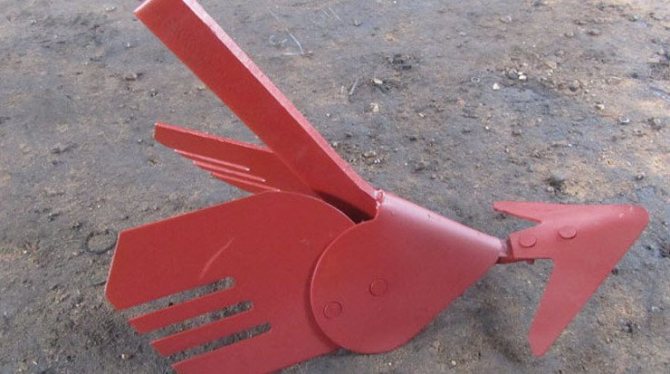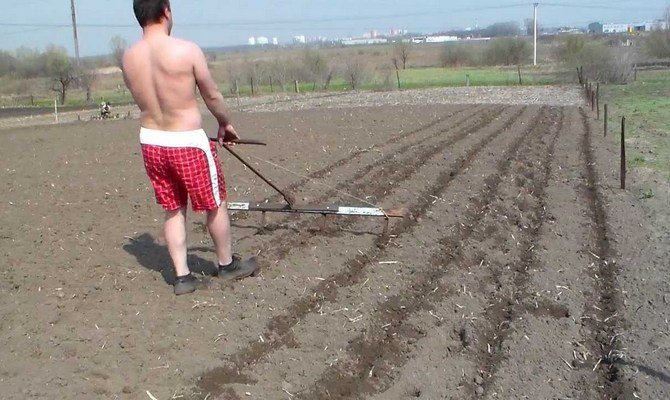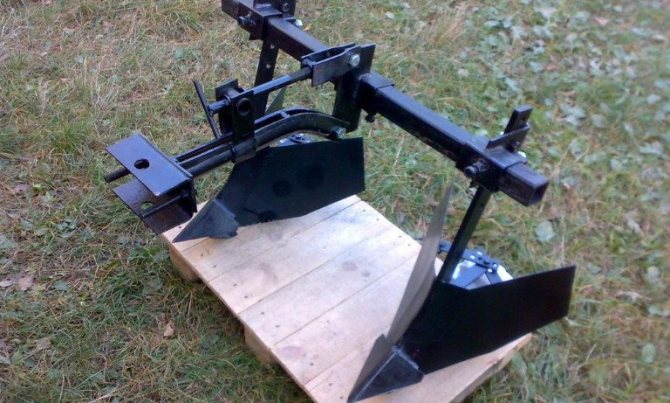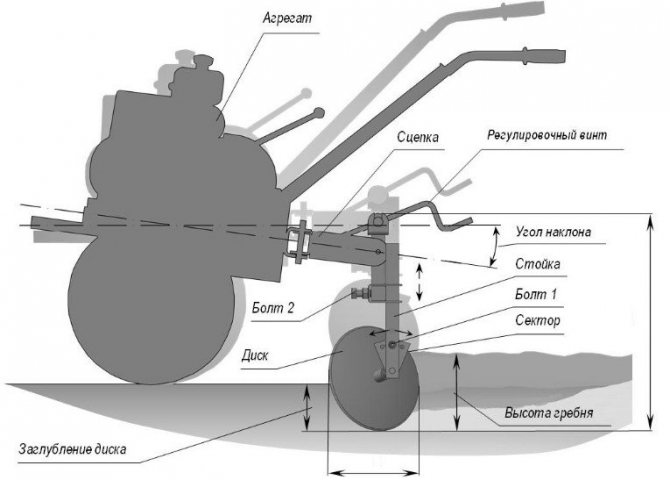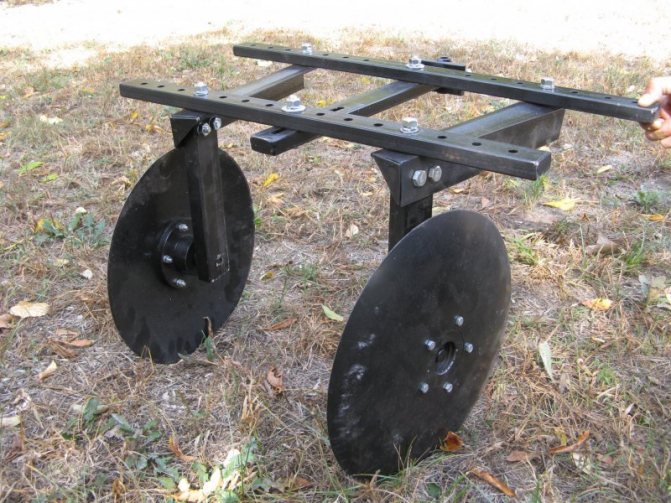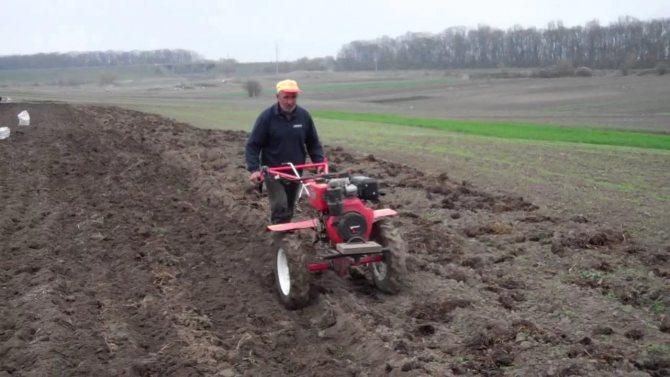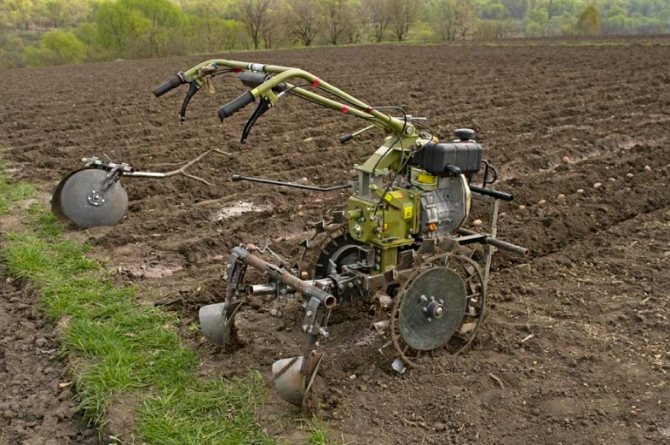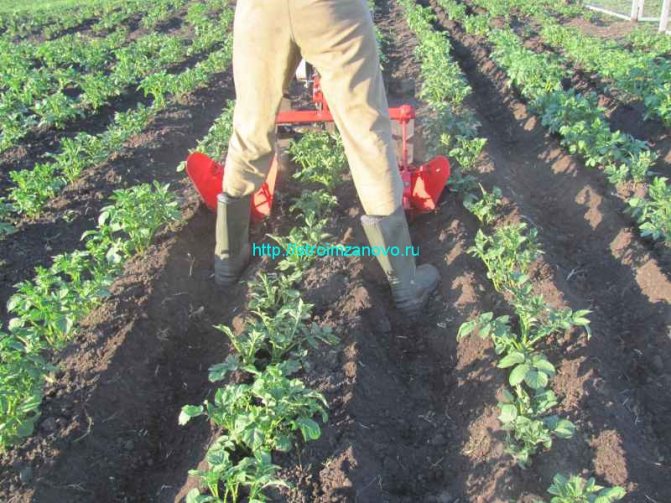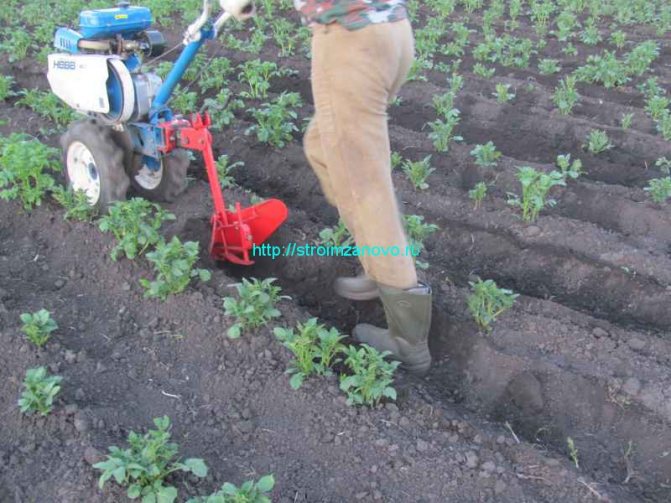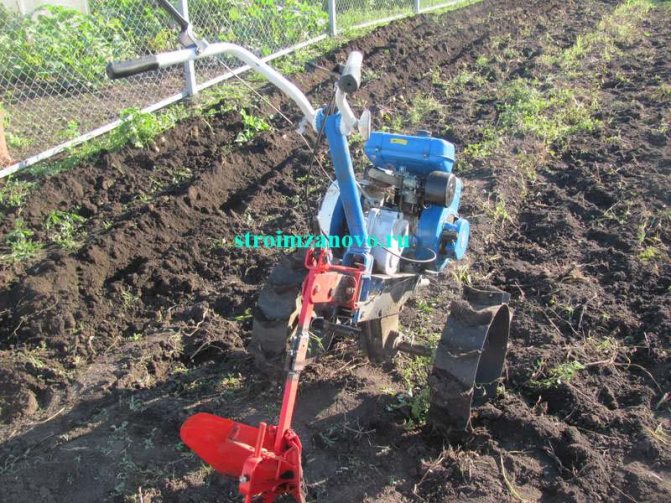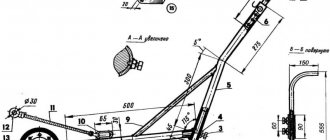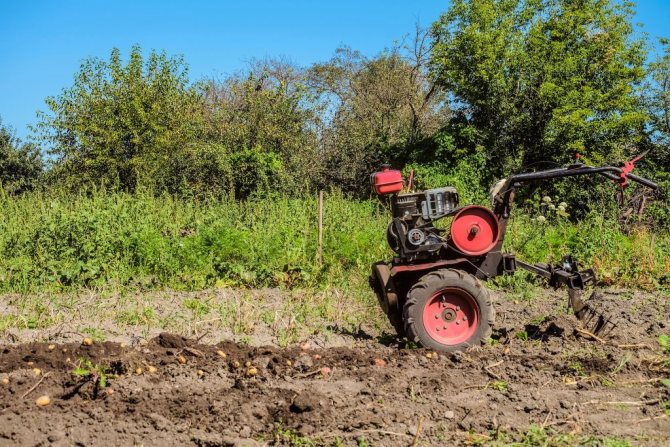
To get a good harvest from potato bushes, you need to properly care for them. Such care should include hilling with a walk-behind tractor, without which the normal growth and development of the plant slows down. Before starting work, you need to study its main features, otherwise, you can seriously harm the plantings, reducing their yield.
Potato planting methods
There are several ways to plant potatoes using a walk-behind tractor:
- the traditional method using a shovel and rake;
- use of a hiller;
- the use of special attachments (factory or homemade);
Planting potatoes with a cultivator
Hiller for walk-behind tractor
Before planting potatoes, you must first prepare and cultivate the soil. If earlier this was mainly done by hand with shovels, which took a lot of time and physical effort, now farmers and summer residents can do this with the help of a cultivator. For high-quality soil cultivation, it is necessary to follow the trail that was laid by the other with one mill. With this method, the soil will be processed to the depth of one shovel bayonet, which is optimal for planting potatoes.
After the plot is prepared, you can start planting seed. For this, the cultivator cutters must be replaced with lugs, having previously installed special extensions on them. On the "Neva" walk-behind tractor, you need to remove the wings and the center stop, putting the hitch in its place. Further, it is necessary to attach a double-row hiller to the hitch, setting the row spacing of 650 mm before that.
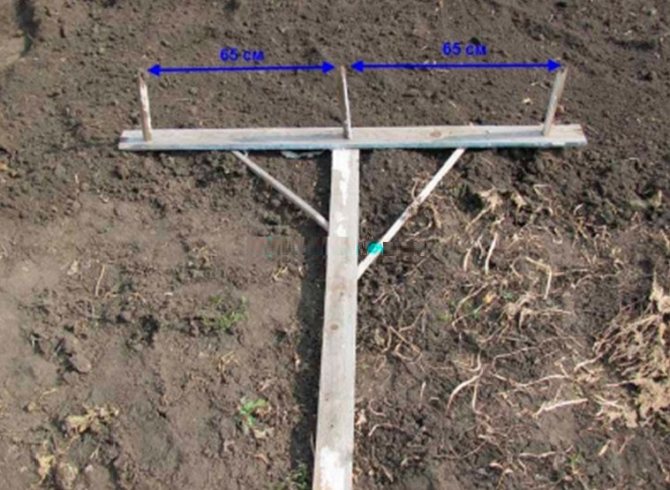

Homemade furrow marker
Before we start cutting the furrows, we first mark them with a marker, which you can easily make yourself. To do this, it is necessary to a long handle, you can take a handle from a shovel or a rake, screw on a crossbar, on which 3 short pegs are screwed with screws at a distance of 650 mm from each other. The marker is ready and you can start marking.
Method advantages
There are several ways of hilling potatoes, the first, the longest, is done with a hoe or a shovel. The hilling quality is good, you can devote time to each bush, but this method is suitable for a small potato plantation. You can also sprinkle dirt on the bushes using a plow. This procedure will require several people, or a horse. Quite time-consuming and tedious process, but still much faster than manual hilling.
In order to spud potatoes quickly and efficiently, modern gardeners use walk-behind tractors. This garden technique is universal and can participate not only in the above process, but also in planting, loosening, digging up the soil.
It should be noted that the hilling time increases significantly. With manual labor, you can spend a whole day on a large area, and you can handle a walk-behind tractor in a few hours. In addition to speed, we can note looser and softer soil, which is maximally saturated with oxygen. It is quite difficult to achieve such results manually.
Important! The hilling process should be carried out on clean soil, without weeds. It is also advisable to drop in the bushes after rain or good watering.Then the result increases significantly.
Modern technology, which is actively used by gardeners, is quite diverse. As for potatoes, in addition to the walk-behind tractor, you can use cultivators and tractors. The essence of hilling remains the same, but the principle of working with this technique and the control features will be different. As for the walk-behind tractor, it should be borne in mind that you also need to get used to this technique. It may not work the first time, you need to gain management skills and experience.
The very design of any walk-behind tractor is quite simple. Two wheels and a pair of hillers, which are located on a metal bar. Before starting hilling, it is very important to set the depth of immersion in the ground of the plane cutter itself, and also to set the angle of inclination. There are different types of motoblocks on the market, there are domestic and imported models, they differ in their price and components. Many gardeners design this technique on their own.
The process of sprinkling the bushes with earth should be started at the first speed, in order to avoid damage to the potato bushes. After the row ends, the walk-behind tractor should be turned and continue to move in the other direction.
Important! For high-quality hilling of potatoes, the walk-behind tractor must be guided exactly in the center. Therefore, even rows with sufficient row spacing will ensure safe and fast operation of the equipment.
Hilling potatoes with a hoe or hoe is a laborious, time-consuming process that can take an entire day. This problem is especially relevant for those whose plantings occupy large areas. Not every gardener wants to waste so much time on traditional methods, so many prefer to use technical means. With their help, the duration of work is reduced to only a couple of hours, while the manipulations are carried out automatically.
On a note!
Hilling potatoes with a walk-behind tractor saves time and energy for summer residents. To convince you of the merits of this method, you can watch a video of hilling potatoes with a mini tractor.
How is the correct planting of potatoes done with a walk-behind tractor
To perform, in addition to the walk-behind tractor itself, you need to acquire additional attachments: lug - steel wheels, wheel extensions, single-row or double-row hiller, universal hitch, milling cutter.
Since the design of these devices is somewhat different for different models of walk-behind tractors, check with the sellers on the spot whether it is suitable for your model, so that you do not return for replacement later. Couplings also differ in design, so it is better to buy it first, and then choose everything else.
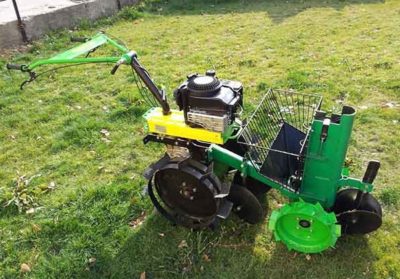

There are two ways of planting potatoes with a walk-behind tractor - an ordinary hiller with an adjustable gap between the wings or a mounted potato planter. Planting with an ordinary hiller is done as follows.
On the walk-behind tractor, grouser wheels and a hiller are placed so that the track width is 60-65 cm, and the gap between the hiller's wings is minimal. On the entire area of the site, grooves are cut with a distance between their crests of 60-65 cm, i.e. If you try and make the first furrow even more even, then all the rest will also be even. Place the potatoes evenly in the furrows.
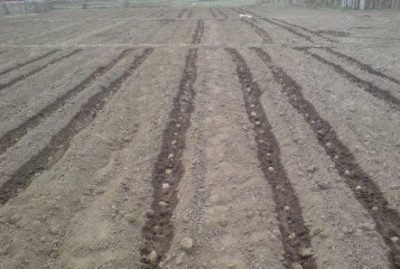

Potatoes in the furrows made by the hiller
Soil wheels are replaced by conventional wheels with rubber tires with the same track gauge. On the hiller, set the maximum gap between its wings and fill the furrows with the hiller. Rubber wheels, rolling along the furrows with potatoes, do not seriously damage its tubers. So or something like this planting potatoes with a walk-behind tractor.
Planting potatoes with a potato planter
If a large area is allocated for potatoes, then it is advisable to plant potatoes with a walk-behind tractor with a canopy - a potato planter. If the planting area is small, then there is no reason to buy an expensive potato planter. Before planting, the site is prepared - the soil on it is loosened with a mill or the ridges are pre-cut.
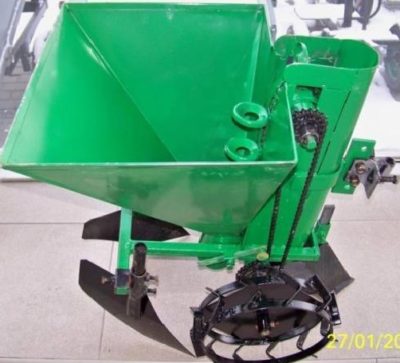

Potato planter for walk-behind tractor
A potato planter for a walk-behind tractor contains a furrow maker, a conveyor for feeding tubers into the furrows and a disc hiller for backfilling the furrows. Due to this versatility, all operations are possible - cutting furrows, laying tubers and filling furrows simultaneously.


As with planting with a hiller, lug wheels are put on the walk-behind tractor before starting work. A potato planter is hung on a walk-behind tractor, standing on a flat surface.


Attaching a potato planter to a walk-behind tractor and adjusting it must be done according to the manufacturer's instructions. The following parameters are usually regulated: the depth of the furrow-maker, the depth, width and angle of attack of the disks of the hiller forming the beds.
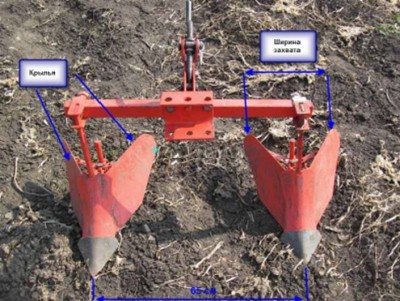

In its most general form, the principle of adjusting a potato planter for a walk-behind tractor is as follows: to obtain a higher ridge, the discs need to be brought closer together and increase the depth and angle of attack; to reduce the ridge, the discs need to be moved apart and reduced the depth and angle of attack.
When planting potatoes with a walk-behind tractor with a double-row hiller attached, lug steel wheels with iron extensions pre-installed on them are placed on the walk-behind tractor.
On the Neva-MB2 walk-behind tractor, you will need to remove the wings before that. We dismantle the central emphasis from the walk-behind tractor; instead, a single-row hitch is placed.


This operation is simple, you just need to insert the steel pins into the holes on the hitch unit. A double-row hiller is connected to the hitch. Before that, set the gap between the hillers at 65 cm, which will set the width of the beds.
Marking the garden with a marker
To do this, attach a crossbar (like a rake) to a long wooden handle and attach short pegs to it on self-tapping screws, like the teeth of a rake. Three pegs are enough with a distance of 65 cm between them. Let's draw a strip on the ground with our marker. For a constant distance between the lines, we lead the extreme peg along the already drawn line.
We will adjust the walk-behind tractor to the markings, turn on the first gear and cut the furrows with a hiller.
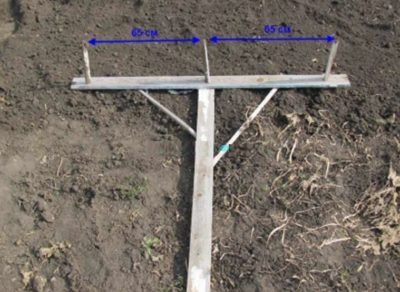

By twisting the adjustment knob on the hitch, you can change the position of the hiller, decreasing or increasing the working depth. Arriving at the edge of the site, we make a U-turn and go back.
You can run one hiller along the already made furrow, but with soft soil you can follow the existing lines. Cut into as many grooves as you need, let's start planting potatoes. Tubers that have been germinated in advance are thrown into the ridge with intervals of 35-40 cm between them.
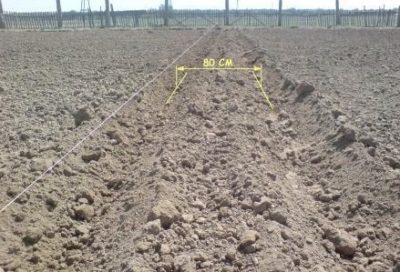

It would be correct to treat them with a liquid from the Colorado potato beetle called "Prestige" before planting. This is a good protection, the beetle is really gone for a long time on the leaves. But as the effect of "Prestige" weakened, a small number of larvae still appear.


After you have finished planting the potatoes in the furrows, you can fill them up. Before that, on the hillers, we increase the width of their wings, pushing their dumps as far as possible, if the design of the dumps allows this to be done. We put the hillers on the ridges of the furrows and at the first speed we fill the potatoes with earth.
This will require some skill, since you need to control two ridges at once.
You can simplify your work by using only one hiller in the center.
We remove the lug wheels and put on the rubber ones. We direct the hiller along the very crest of the furrow and, bed by bed, fill up all the potatoes.If you have not a two-row, but a single-row hiller, then you can do the entire planting of potatoes with a walk-behind tractor with it, setting the width between the ridges to 70 cm, which is the optimal size. At the end, irregularities in the beds are corrected with an ordinary hoe.
What walk-behind tractors can be used
Today, various models of walk-behind tractors can be used for planting potatoes. Each of them has its own distinctive features. Often, summer residents use the Neva walk-behind tractor. This is a reliable and unpretentious unit that is perfect for working at a summer cottage. Using such a walk-behind tractor, you can carry out various works in the country.
A similar principle is observed for the Bison and MTZ units. This is explained by the fact that the design schemes are the same and differ little. This suggests that planting potato tubers with the help of Bison can occur in two ways. MTZ walk-behind tractors remain no less popular today.
But how to get rid of the wireworm in potatoes with folk remedies, and what means should be used, this information will help to understand.
In the video - Bison walk-behind tractor for planting potatoes:
They are distinguished by reliable and durable parts. Such a technique rarely fails, since it uses high quality materials during its assembly. In addition, the unit is economical as it consumes little fuel. It remains a powerful species in its class. But how the vibrating potato digger is used for the Neva walk-behind tractor, this information will help to understand.
The following characteristics are characteristic of the MTZ walk-behind tractor:
- slight vibration;
- work is carried out with low noise;
- easy start;
- Ease of Management;
- environmental Safety.
MTZ is distinguished by its ease of operation. In addition, it is so easy to operate that even an inexperienced person can perform all the work. And its maintenance can be done quickly and easily, even with your own hands, thanks to which you can save money.
Also, for planting potatoes, the Salute walk-behind tractor can be used... This is a multifunctional unit, in which the cutter grip will be 80-105 cm. Salute is produced with several variants of gasoline 4-stroke engines from different manufacturers.
It will also be interesting to know if you can plant tomatoes after onions.
Planting potatoes is an important event in the life of every summer resident. You need to properly prepare for it. Then it will be possible to get a high-quality high yield. To simplify your task, you can use a walk-behind tractor for these purposes. This unit allows you to do everything quickly, simply and efficiently.
How to get a good harvest of potatoes, how to plant them correctly
Types of potato ridgers
Types of potato ridgers to the tractor
Cultivator Mantis - a means of cultivating the land in the country
Planting potatoes under a plow with a walk-behind tractor
It is possible to plant potatoes under a plow with a walk-behind tractor, with which the vegetable garden is plowed before winter with turning over the earth. We will describe this method using the example of the Favorit walk-behind tractor. Before planting, we put steel lug wheels on the walk-behind tractor and attach the plow.
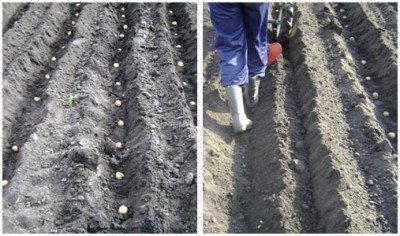

You do not need to mark the garden with lines. We cut the first furrow with a plow. This method is distinguished by the need to immediately throw tubers into the garden. After throwing in the tubers, turn the walk-behind tractor so that the right wheel is in the garden bed, and fill it up with earth from the next furrow.


The fact that the lug goes over the potato does not damage it. So, at the first speed of the walk-behind tractor, we land in the garden bed behind the garden bed. Saving time with such a planting of potatoes with a walk-behind tractor arises due to the fact that we cut one bed and at the same time fill up another, and the ridges are cut straight, since one wheel goes along a ready-made furrow.
Hilling process: how it happens
So, it's time to huddle potatoes with a walk-behind tractor.The first thing to do is to put some loosening agents in front of the structure. The hiller, which was discussed above, will be located at the back. When all the necessary manipulations are done, you can start processing. To do this, the walk-behind tractor is placed strictly in the center between the rows of potatoes and the minimum speed is turned on. The process has started.
The potatoes are piled up to the end of the ridge, then the walk-behind tractor is carefully unfolded and the next aisles are processed in the same order. According to many gardening experts, potatoes can be hilled with a walk-behind tractor only once. During the second treatment of the bushes, there is a high probability that the tubers themselves will be damaged.
If it is decided to spud the potatoes with a walk-behind tractor, then you need to take care of the "correct" planting of the seed in advance. Processing with this technique is possible only if the distance between the rows of plants is approximately 65-70 cm.
As you can see, hilling potatoes with a walk-behind tractor is very simple. If you master the principle of work and begin to apply it in practice, the saved time can be spent on solving other important matters.
Hilling potatoes with a walk-behind tractor - video
Planting methods for potatoes
There are two planting methods. They differ in the tools used:
- Hiller with a regulator
- Mounted potato planter.
Both options are equally popular with summer residents. It's just that the first option is used for a small area, and the second for a large one. But the first option is also cheaper. Well suited for those who like to save. So, let's take a look at each of them.
Motoblock with hiller
Its design consists of the following elements:
- Conveyor - a conveyor that delivers seed.
- Furrower - creates furrows.
- Distributor - with its help, the tubers are planted in a strictly specified period of time.
- Hiller - loosens the soil and covers the crop with earth.
This tool works according to the following principle. Before starting work, metal wheels and a special hopper are installed on the tool. The wheels create furrows. They should be even, then the growing process will be simplified.
Potatoes are placed in the bunker, which, when moving, will fall out into the holes. After that, the wheels are replaced from grouted to rubber ones and they are installed along the track width. This will prevent damage to the root crop.
Further, the hiller covers the potatoes with soil, simultaneously tamping it down. In addition to manually adding tubers to the hopper, the entire planting process takes place automatically.
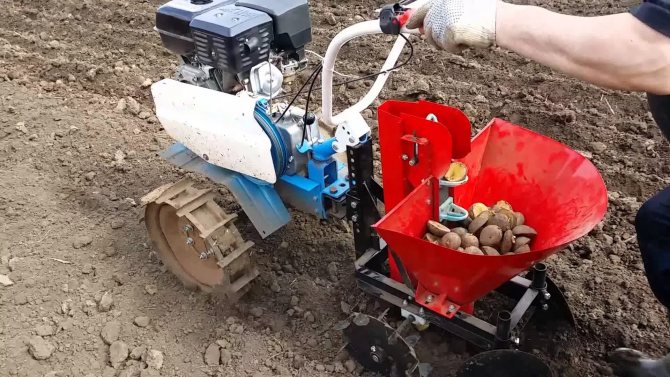

Mounted potato planter
Before using the potato planter, you will have to carry out a preparatory stage for planting. First you need to plow the land. Then harrow so that the crop receives the required amount of water and oxygen. After that, you need to moisten the soil (if possible).
This type of walk-behind tractor has the following design:
- furrow makers;
- special bunker;
- disk device for backfilling potatoes with soil.
The structure of the motoblock-hiller allows you to plant potatoes in one approach, since the tool simultaneously makes furrows, pours out the tubers and covers them with earth. Before use, you need to attach special wheels for grabbing the soil and an additional attachment - a potato planter.
Field plowing equipment
The modern park of mini tractors has about two dozen devices, domestic and imported, differing in functionality, power, price. Let's consider the most popular ones.
Motoblock "Neva"
Domestic unit from the well-known summer residents. It is a powerful device capable of working on any soil.
Among the advantages:
- ease of use;
- reliable motor with high efficiency;
- durable body, preventing damage to the mechanism;
- the ability to work with attachments designed for a wide range of jobs.
In addition, this type of motoblocks provides the user with ample opportunities to choose the optimal speed and comfortable handle position. At the same time, according to gardeners' reviews, the "Neva" has not proved itself very well in the mode of working with a plow (shallow plowing depth).
The disadvantages can be considered high weight (more than 90 kg), insufficient stability on uneven soil, high cost.
Motoblock "Salute"
The author of this device, the Salut Association (Moscow), did everything to make it as convenient as possible in operation. Its center of gravity is lowered and the engine is moved forward, making it easier to control than the Neva and is able to easily maintain balance when connecting the plow.
Another advantage is its low weight and maneuverability, which makes it possible to use Salyut in small areas. It should also be noted that the handles of the walk-behind tractor are narrowed and can be rotated 180 °, which makes it very convenient for harvesting.
A significant drawback is the lack of a differential, which makes it difficult to turn and makes it inconvenient to use the bogie. In addition, some types of "Salut" are characterized by a high noise level.
Motoblock "MTZ"
The brainchild of the Minsk Tractor Plant attracts with its compactness and maneuverability. Despite its high weight, the device is perfectly balanced and therefore extremely stable.
The latest modification - MT3 09H will become a universal assistant for the gardener, and if you purchase an additional adapter with a seat, the walk-behind tractor can be turned into a mini-tractor. Among other advantages - wide functionality, large volume of the fuel tank, high power.
It should be remembered that MTZ is more intended for processing large areas; it is unprofitable to use it in small areas. In addition, the unit is picky about the choice of soil: it is not recommended to use it on heavy soils.
First you need to level the area, plow, loosen.
The difference between a walk-behind tractor and a cultivator - the latter uses a cultivation cutter
For these purposes, motorized devices are used in the form of a walk-behind tractor, a cultivator on a motor or a mini-tractor. People have invented a walk-behind tractor - the most suitable, low-cost equipment for planting potatoes.


The advantage of a motor-cultivator is that with the help of a cultivating cutter, the soil is prepared, beds for sowing are cut and inter-row cultivation is carried out up to harvesting root crops.
Mini tractors are used in small farms for plowing, transporting goods, cleaning territories. All small-sized equipment solves the same questions: how to help agricultural workers.
Read more: Ostrich speed (55 photos): a fast running bird, what is the average and maximum
How to plant potatoes with a walk-behind tractor
Pre-planting preparation
Before planting, it is imperative to cultivate the land: plow it and harrow it. Thanks to this, the soil will be saturated with oxygen, and it will dry out a little. This is done using a plow or a special cutter.
The beds are crushed (harrowed) in two ways: using a hand rake or a walk-behind tractor. The choice of tool depends on the area of the site and your own desire. But the second option is preferable. After all, some tools, when planting, loosen the earth very well. At the same time, the loosening depth reaches 20 centimeters.
After that, the rows are marked. For potatoes to grow better, you need to make free aisles. The average distance between them should be 60-70 cm. The distance of the rows depends on the type of potato. After cultivating the land, you can start planting potatoes under the walk-behind tractor.


Landing technique
Regardless of how the work will be carried out, one rule should be followed.The planting depth should not be less than 10-15 centimeters, and the distance between the tubers (seeds) should be 20-30 cm. For ease of orientation, you can pull the rope. Potatoes will germinate better if you fertilize the soil after loosening.
Working with a hiller. First, it is attached to the walk-behind tractor. Using the device "Neva" will have to move the dumps to increase the wingspan. This is necessary for the correct placement of the potatoes in the holes. When working with Salyut, you do not have to go through this procedure. The lug wheels are attached to the unit.
The track width of the walk-behind tractor for planting potatoes is 60 centimeters. The tops must be planted at the same distance. After sowing, it is necessary to remove the metal wheels and put the rubber ones. In this case, the width should remain the same. The wings are at their maximum distance. Now you can cover the crop with earth.
There is another option for using a walk-behind tractor - use it for a plow. Metal wheels and a plow are installed on the device at the same time. When planting in this way, it is worth throwing potatoes at the stage of creating a furrow. This must be done immediately, since the tool, when creating a new furrow, floods the seeds in the already created one with earth.
Below you can watch a video on how to make a landing with a "plow" walk-behind tractor.
Instructions for use
Hilling potatoes with a walk-behind tractor significantly simplifies the life of summer residents. This work is quite simple, but it is better for an inexperienced gardener to first learn practical skills from an experienced driver of such a technique. Before starting the device, you need to fill up with gasoline and check the oil level. Forgetting this can ruin the car. It is better to choose gasoline of the same brand with the engine.
When the preparatory phase is complete, the workflow begins. Throughout its entire length, the hiller must be immersed in the ground. To lower the structure, you need to tilt the rack back. In case of excessive immersion, it must be deflected in the opposite direction. When everything is ready, the unit must be placed between the rows and turned on at the lowest speed. At the end of the ridge, the car gently turns around and the action is repeated. In order to properly huddle potatoes with a walk-behind tractor, you need to carefully study the instructions for working with this device. We must not forget about safety precautions. If it's difficult to figure it out right away, you should watch the video of hilling potatoes with a walk-behind tractor.
The scheme of planting potatoes with a motor cultivator
Before planting potatoes, the soil must be loosened and, at the same time, furrows must be created. You need to plant potatoes at a time when the soil temperature reaches 8-9 degrees. At a depth of 10 centimeters. The furrows should be made as even as possible, and the distance between them should be about 60 centimeters. This is done so as not to hurt the planted tubers when loosening the soil.
After finishing cultivating the land, the potatoes are manually placed in the holes. The distance between tubers should be 30-50 centimeters. After that, the field is again processed by a motor-cultivator for backfilling the potatoes with soil.
In doing so, it saves a lot of effort and energy. All work and planting with the cultivator is carried out automatically. You will have to work with your hands only when harvesting.
If the site is located next to groundwater, then the future harvest should be protected from excess water. In this case, planting potatoes can be done directly into the ridges. The ridges are formed by a walk-behind tractor 20 centimeters high. But this method of growing potatoes will only help where the soil is well hydrated.
Testimonials
Different gardeners have a different impression of using the walk-behind tractor. Some argue that the use of a potato planter is easier for them, it is convenient to use. As consumers say, ease of control for them is one of the highest priority points in the operation of this technique.Gardeners also place great emphasis on versatility, as the planter simultaneously digs, plants and then safely buries the potatoes in the ground. After such a procedure, there is practically no need to spend additional time leveling the ground.
Many gardeners say that even non-innovative technology can greatly simplify planting potatoes. For example, even the old "Neva" is able to speed up the process and make the beds smoother. This technique is very convenient and really saves time spent on disembarkation.
Cleaning potatoes with a walk-behind tractor
Hilling
A month after planting, the first shoots appear. Now, with the help of a walk-behind tractor, you need to spud the potatoes. It is worth starting this process when the height of the shoots reaches 15-20 centimeters.
Hilling itself is a replacement for loosening the soil and weeding it. At the same time, this procedure protects the harvest in spring from recurrent frosts. It happens that by the time the seedlings appear, the temperature may drop slightly below zero. And a layer of soil covers the fruits, warming them and allowing them to survive the bad weather.
Usually they spud 2 times: the first time as the sprouts appeared, the second - after three weeks. But you need to know that if:
- The nest begins to grow wider across the crest;
- Tubers peek out from the ground and turn green in the sun
Will have to spud the third time. There are times when potatoes have to be hilled 4 times per season. But then a good harvest is obtained.
Any hiller is suitable for this procedure - with one, two or three rows. If necessary, an additional nozzle is installed on the walk-behind tractor and with its help the soil is fertilized.
You can see how a two-row hiller works in this video.
Hilling secrets
Many gardeners huddle potatoes in the summer heat. But it's not right. This can damage the shoots or the root crop itself. The plant may wilt because of this. In addition, the procedure has a negative effect on health.
Therefore, it is recommended to do this in the morning or in the evening. And not in dry weather, but after rain, when the soil dries up a little, but remains moist enough. This makes it easier to get rid of weeds and weed the beds.
And it is much easier to huddle wet soil, since wet soil does not crumble. Wet soil poured onto the base of the stem stimulates the development of new shoots. And this leads to an increase in the yield.
Why do you need to conduct, terms and conditions
Potatoes are one of the most popular crops among gardeners and gardeners. Hilling involves raking the soil, sprinkling it on the lower part of the plant stem. The procedure helps to increase the amount of the harvest, improve the quality of vegetables.
Benefits:
- the growth of the bush - the stems (stolons) are strengthened, a larger number of tubers are formed on the root system, the metabolism is accelerated, the foliage of the culture is growing;
- protection from wind, low temperature - in spring, when the plant has not yet matured, frosts are frequent, the hillock creates an additional layer of soil above the root system;
- removing the soil crust - loosening enriches the soil with oxygen, allows water to penetrate faster to the roots;
- removal of weeds - it is not always convenient to pull out weeds by hand, some of them retain the root system (which means that a new "unwanted element" will grow in the near future);
- reducing the number of green tubers - if the new potatoes are not sufficiently covered with soil, the vegetables will begin to turn green, and hilling increases the volume of soil around the bush.
If you plant potatoes shallowly, weed, huddle on time, it will be easier to harvest. In addition, the hillock forms clearly delineated ridges of the rows, which facilitates the treatment from pests (for example, the Colorado potato beetle).
Harvesting
It is convenient not only to plant potatoes with a walk-behind tractor, but also to collect them. This is done in early autumn (September-October) in dry weather.For this, an additional attachment is installed on the unit - a plow. It is sometimes called "potato digger".
You can watch how the cultivator is harvested in this video
But you don't have to use it. It is enough to use a single-row hiller. He will lift the ground, and the potatoes will lie on the edge of the garden. It remains to go around the site and collect the ripe crop.
To avoid sprouting potatoes, place them in a cool, dark place after harvest. There he should lie for 2-3 weeks. After that, the potatoes need to be sorted by size. And only after that send it to the cellar.
Planting and harvesting potatoes (video)
The walk-behind tractor helps gardeners to plant potatoes quickly and efficiently, saves energy and saves time. The video below shows the whole process of planting and harvesting potatoes using a walk-behind tractor. Here it is shown in detail and described how this is done on the "Neva" and "Salyut".
Do you use a walk-behind tractor in your garden when planting potatoes?
Soil preparation
Correct processing of the garden with a walk-behind tractor is carried out using special attachments or hook-on devices. After this action, the soil is enriched with oxygen, all weeds are removed, and the tubers grow freely and faster. This task is for every summer resident and is performed without much difficulty. The main thing is to adjust the attachments before plowing, adjust the plow grip (by rotating the handle on the universal hitch). If everything is done correctly, then holding and guiding the walk-behind tractor along the furrows will be easy.
The attachment for the walk-behind tractor has a special plow that makes uniform furrows to a certain depth. After that, manually or with the help of a potato planter, the potatoes are laid out in furrows and the tubers are covered with soil with the hillers.
After 2-3 weeks, when all the seedlings have already appeared, the next process begins, which can also be performed using a walk-behind tractor. The entire planting area is divided into furrows, the soil is loosened up and paths are formed for convenient movement between rows. Hilling has a beneficial effect on the process of stem germination, removes weeds, retains moisture in the soil, and forms an excellent defense of young plants from the first frost.
This process is provided by a special nozzle on the walk-behind tractor - one, two- or three-row hiller. During hilling, fertilizer should be applied to the soil with an additional nozzle, which is installed on the potato planter.
During the flowering period, potatoes need special loosening of the soil between the rows, which will allow the root crop to grow faster, guaranteeing a good harvest. The first time the potatoes are weeded with a walk-behind tractor on the eighth day after planting, at this time a dense crust appears on the ground, which complicates the growth of the stems.
And then - every 7 days, until the aisles become inaccessible. Weeding can be done either manually or mechanically. The main thing is to remove the weeds in time, so that they do not complicate the growth of seedlings and do not negatively affect the development of the root crop.
Such a device is put on a walk-behind tractor. Mesh cells have a side of about 20 cm, located at an angle of 45 degrees. The harrow is effective due to the fact that it covers a large area at once, but it will not be possible to process the row spacing with it “cleanly”. The best way to eliminate weeds is to pull them out by the roots.
As soon as the earth dries up, it needs to be loosened. Preparing the soil before planting is necessary so that the earth warms up better after winter, becomes soft and saturated with air.
Depending on the condition of the site, this is done:
- plow with subsequent harrowing;
- cultivator.
With plowing, mineral and organic fertilizers are introduced into the soil. What to choose a plow or cultivator? On this score, experts have no consensus.Harrow plowing is twice the labor and fuel expended than cultivation. However, on heavy or uncultivated land, the cultivator simply "will not take" the plot.
If you have sandy soil or a well-cultivated area, without perennial weeds, with soft soil, then you just need to go through it once with a walk-behind tractor with a cultivator before planting potatoes.


Important! It is very good to let the soil stand after pre-planting until the annual weeds germinate to the white thread stage. By planting potatoes during this period, you will prevent them from growing, which will greatly simplify further weeding.
Cultivation is carried out from the edge of the site, in the direction of future potato rows, driving the walk-behind tractor back and forth. In order for the processing to be uniform and complete, the already plowed edge should be grasped with each pass.
You can carry out cultivation and round, finishing work in the center of the site. However, it is wrong to do such processing for planting potatoes, because after that you will have to align the circles for cutting longitudinal straight rows.
After winter, check the operating condition of the walk-behind tractor, the oil level.
Immediately before cultivation, you should:
- hang metal lug wheels or cutters;
- hang a plow or hiller;
- check the fuel level;
- remove the braid from the lock;
- open the fuel supply;
- turn on the ignition with the toggle switch;
- pull on the starter cord.
After processing the soil and cutting the ridges, the iron wheels on the walk-behind tractor should be changed to rubber ones. Further work on planting potatoes with a walk-behind tractor is carried out on a rubber track so as not to injure the tubers in the soil.
The pre-planting preparation of the root crop takes time and effort. On a standard plot of 6-7 acres, you will have to plant it in a shovel all day, but by connecting the equipment to work, you can handle it in three hours. For small-sized plots, motoblocks Neva, Forza, Sadko, Don, Hooter, Champion, Carver are popular.
Read more: Cherry did not wake up after winter. Why cherries dry and how to save a tree
To begin with, seed is prepared. Preference is given to zoned varieties that yield good yields in certain regions. Sorting is done in order to select good raw materials. The potatoes are selected of the same size.
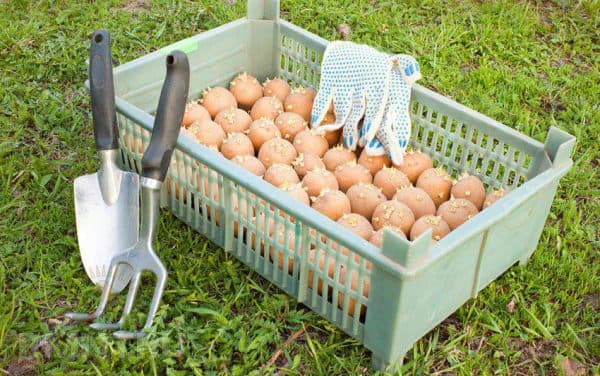

Tuber preparation
Small tubers give a small yield. Large ones must be cut into pieces, and this provokes various diseases and opens up direct access for pests. Germination takes about a month. For this, the seed is placed in a warm (12-15 degrees), bright room.
If dark spots appear on fresh sprouts, this indicates a disease. Affected tubers are discarded. Before planting, soaking is carried out in stimulating and etching substances. It is not recommended to place tubers in the solution for a long time.
It is better to lay them out on a flat surface, spray them with preparations and let them dry. You can plant root crops when the ground warms up to 7, 8 degrees (in the planting hole).
Presowing work begins with the laying of mineral or organic fertilizers in the fall.
Stages of preparation for sowing in spring:
- Immediately before planting, it is necessary to plow the soil to the depth of a shovel bayonet (12-15cm). To do this, you need a nozzle - a cutter.
- When planting potatoes under the Neva walk-behind tractor, the wings are removed from the unit before work. The equipment installed on the walk-behind tractor should be properly adjusted. This will ensure that the machine runs smoothly and requires a minimum of effort. A well-plowed field does not need harrowing.
In more detail about planting potatoes with a Neva walk-behind tractor, you can watch the video online:
- Bury to saturate with oxygen and moisture. In a well-loosened layer of soil, crops sprout more amicably.At this stage, the walk-behind tractor will greatly facilitate the process of preparing the soil before laying the seed.
- Complete set of the walk-behind tractor.
For plowing, you will need wheels with lug elements, a set of rubber wheels, wheel extensions, a milling cutter, a universal hitch, hillers or a plow. If you are going to purchase additional attachments, the first step is to buy a hitch. The rest of the elements are selected for it.
Weeding
A week after planting, you should loosen the soil. During this time, a dense crust formed on the ground, which interferes with the germination of plant stems and the access of oxygen. Weeding is carried out weekly. This helps to control weeds that negatively affect root crops.
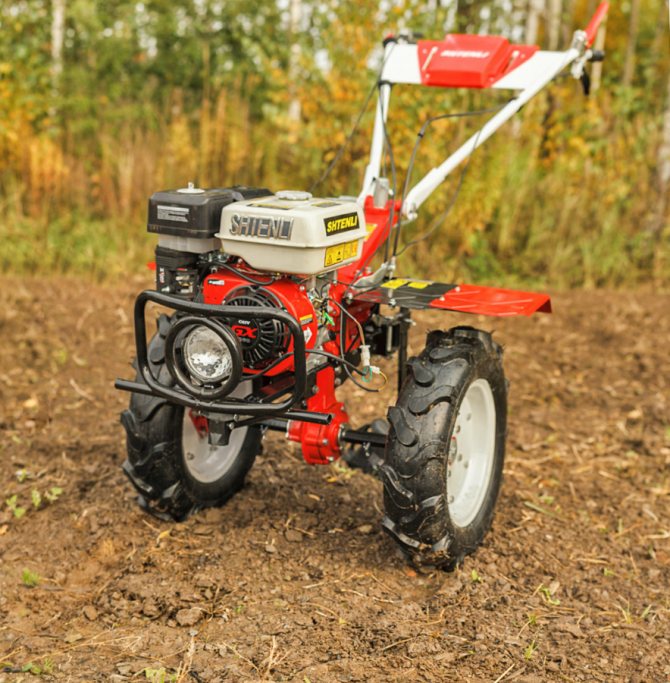

For weeding work, a rotary or mesh harrow, tines and a weeding machine are used.
Hilling
Seedlings appear in 3-4 weeks. Now, after planting, you need to spud the potatoes. The walk-behind tractor will help with this. For hilling, one, two or three-row hiller is suitable. If desired, you can apply fertilizer by installing an additional nozzle.
The walk-behind tractor is used not only for planting, but also for harvesting potatoes. By the fall, the potato tops dries up, and everything is ready for harvesting. You need to dig potatoes in August - September, in dry weather. For digging with a walk-behind tractor, a mounted plow or potato digger is installed.
But you can get by with a single-row hiller, which will raise the earth and the potatoes will lie along the edge of the ridge. It remains to go through and collect the potatoes. Planting and processing potatoes with a walk-behind tractor are far from all areas of its application. Technical innovations have greatly facilitated the work of summer residents.
The motoblock has now become a necessary tool for the cultivation of a land plot. The unit is well worth the investment. How you can use walk-behind tractors, in addition to planting potatoes, can be found on the sites "Tips of an old plowman".
The choice of attachments depends on the requests of the owner. The example of planting, hilling, weeding and harvesting potatoes shows how the use of a walk-behind tractor simplifies life for gardeners.
Planting potatoes with a walk-behind tractor
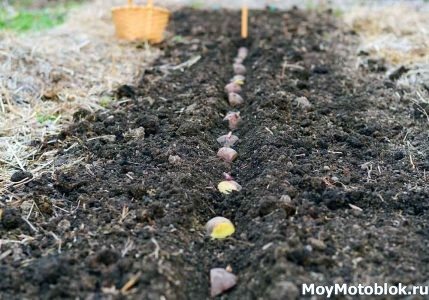

The use of a walk-behind tractor and attachments (wheels with grousers, hillers, plow, planter) greatly facilitates garden work on an area of over 20 acres.
For gardeners, whose land area exceeds 20 acres, it is difficult to manually cultivate the land when growing potatoes. Especially if the soil is clay or black earth, which is considered heavy soil. Significant relief can be achieved by buying a walk-behind tractor of the Salyut, Centaur, Oka, Neva or any other brands. Relatively inexpensive mechanisms are maximally adapted for field work in the Russian Federation.
Selection recommendations
If you need to buy equipment for hilling potatoes with a cultivator, do not rush. First, it is better to study the recommendations for her choice. There is no need to chase excessive savings, otherwise you may face the low quality of the device. If the soil in the garden contains sand and clay, then you need to take a unit of increased power, which will not be interfered with by lumps.
The service life of garden equipment largely depends on the amount of horsepower. For large plots of several hectares, you should not buy weak cars - they will quickly fail. The best way out would be to purchase a powerful walk-behind tractor with a large soil grasp width exceeding 60 cm. Standard models will do an excellent job on an area of 15-20 acres.
How to plant potatoes with a walk-behind tractor
In addition to the walk-behind tractor, additional attachments will be required, depending on the planting method: a hiller, a plow or a potato planter directly.
In rural areas, potatoes are used not only to feed the family until the next harvest. People grow it for sale, as well as to feed domestic animals. The need for a vegetable is quite high.Large areas are planted that require quick and timely care: weeding, hilling, harvesting.
Preparing the soil for planting
Before starting the main work, you need to prepare the soil for planting potatoes. A cultivator or cutter is the main tool for soil cultivation that can be installed on a walk-behind tractor. It is often included in the equipment kit, but if it is not provided in the kit, then it must be purchased separately. On some models, it can be installed instead of wheels, like on a motor-cultivator, in others, the cutter is used as a separate attachment.


The cultivator is suitable for processing light sandy, sandy loamy soils, black soil, as well as for spring tillage after it has been deeply plowed in autumn with a plow. It is necessary to loosen the soil on a potato plot in dry weather, to a depth of about 10-15 cm. Clay soils need to be processed 2 times to rid them of excess moisture and additionally enrich them with oxygen.
If the site has heavy clay soils or its area is significant, it is easier to dig up the ground with a plow, which allows you to go deeper into the soil. With its help, you can not only prepare the soil for planting tubers, plant them, but also dig out the harvest in summer or autumn. When plowing a plot, a conventional plow can be used, a reversible plow that can be plowed in both directions, or a rotary plow, consisting, like the milling cutter, of 2-4 curved plowshares.
After plowing a potato plot with a cutter or plow, large clods of earth remain, which then need to be broken up and leveled well, for which the harrow is intended, which is also installed on the unit (disc, finger or rotary).
Planting with a disc hiller
Planting potatoes begins with plowing the area and dressing the seed from pests. Wheels with grousers are used to prevent slipping during rather heavy work of the mechanism. Furrowing is done with an ordinary hiller, adjusting the minimum distance between its wings.
Recommended furrow parameters:
- row spacing when planting 55-70 cm - depending on the track size of the walk-behind tractor;
- the potato is located in the furrow at a distance of 25-35 cm - it depends on the type of soil, potato variety, fertilizers applied;
- planting depth 12-15 cm.
Planting potatoes with a hiller is the most profitable way, because except for the hiller itself, no special attachments are required.
At the second stage, instead of special wheels, ordinary wheels with a rubber tire are installed, and the hiller's wings are extended to the maximum distance. The mechanism is installed between the furrows with the spread out potatoes exactly in the middle, observing the size of the track. Two rows fall asleep simultaneously from one side and the other. Soft tires, passing through the row, do not cause significant damage to the planting material.
Features of hilling with a walk-behind tractor
In order to facilitate the processing of large areas of culture, special devices are used.
The method of hilling with a motor-cultivator requires compliance with the following features:
- Compliance with the number of procedures. To obtain a harvest, it is necessary to perform 2-3 procedures. Gardeners carry out one hilling procedure, but this is wrong, since potatoes require proper care throughout the entire ripening period, the harvest largely depends on this.
- The distance between the rows must be respected. So that the bushes are not damaged during the process. The distance is at least 55 cm.
- The rows should be even, this will facilitate the processing process.
- Before starting the procedure, it is necessary to check the angle of inclination of the blades and the depth of immersion.
See also
Description and characteristics of the potato variety Kamensky
To read
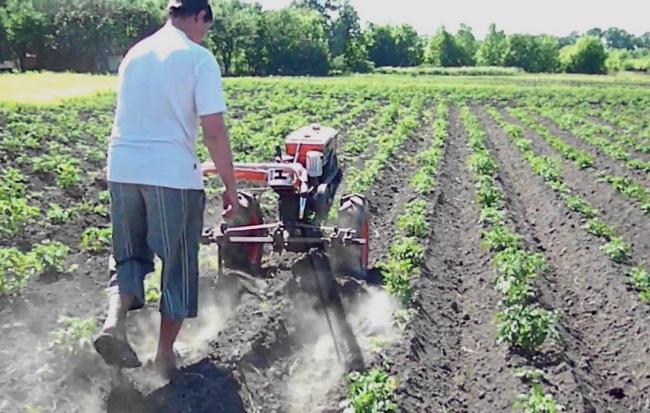

It is easier to work with a tractor, since no physical effort is needed.
Planting a potato planter
Potato planter - a hinged mechanism for a walk-behind tractor, consisting of a disc hiller, a hopper for planting material, a furrow maker and a conveyor that feeds tubers into the furrow - a one-piece complex for planting potatoes. The person plays the role of a process controller.
The planting speed is about 12 acres per hour, therefore, in a small area of the garden plot, the use of an expensive mechanism is unprofitable.
It is recommended to adjust the trailed potato planter to the walk-behind tractor exactly according to the manufacturer's instructions, setting the necessary parameters for the planting depth of potatoes, the distance between the rows and tubers in a row and the angle between the disks of the hiller.
Varieties of hillers
When purchasing hillers and other similar equipment for the first time, it is important to familiarize yourself with the model range, and - most importantly - with the peculiarities of work, nuances, and purpose.
Main classification:
- single-row (one row is hilled);
- two-row (allows you to process two aisles at the same time.
The last option is considered improved, but it is more difficult to work with it - the device has a greater weight, the value assumes a certain skill of work.
Disk
It has a different wing shape - instead of the standard triangular hiller, round (disc) nozzles are used. Many models have the function of choosing the width of the working angle - the range is 50-60 cm.
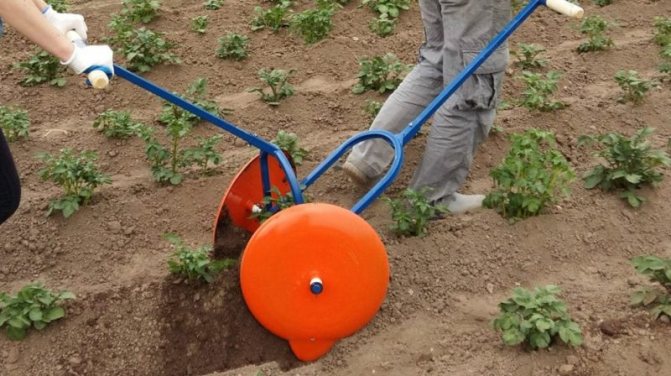

Benefits:
- disc models are lighter;
- the soil is looser, crushed;
- energy consumption is reduced (compared to propeller-type models).
Disc wings create uniform embankments for plants, and loosening is more efficient.
Plow-shaped
Such a hiller has a simple operating principle and design. The base is a triangular central element. One or two hillers can be used at the same time (the latter option will require a powerful motor). Working with single plow nozzles is slower than with disc nozzles. The cost of the equipment is also significantly lower.
See also Sineglazka Variety: characteristics and description of potatoes
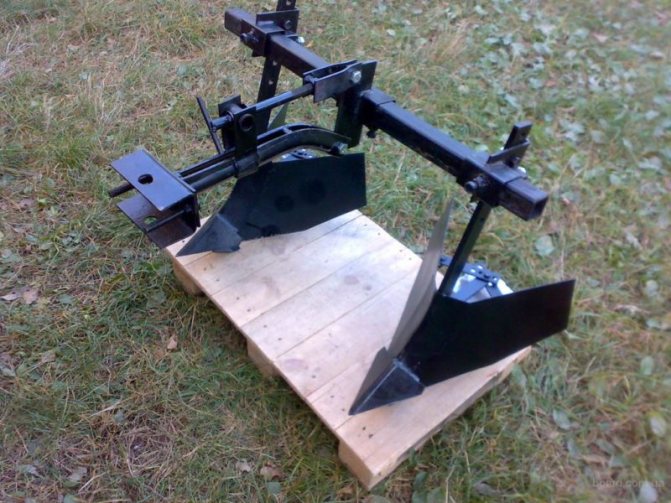

Planting potatoes under the plow
It is recommended to loosen the soil with a cutter beforehand. The wheels of the walk-behind tractor must be replaced with lugs.
Planting works are carried out in two stages:
- First, a furrow is laid in which the potatoes are placed.
- On the way back, the vegetables are covered with a dump when cutting the next furrow. In this case, one wheel of the unit goes along the laid row, as a result of which the same distance between the rows is observed.
At the beginning of the path, the plow depth is adjusted in the ground (usually the size of the shovel bayonet is used). The distance between the furrows is adjusted according to the track width between the wheels of the walk-behind tractor. Work is done at first speed.
Ridge landing
How to properly plant potatoes in a highly humid area:
- high ridges of the earth (height 20-30 cm) are cut using a disc hiller;
- potato tubers are laid on the top of the ridge and covered with loose earth taken from the row spacing;
- furrow depth and ridge height change as the angle of attack of the discs decreases or increases.
Planting potatoes is a rather laborious process that requires a certain amount of physical strength and time. The best way out is to use walk-behind tractors with attachments, which significantly speed up the work. Different brands of mechanisms do not make any fundamental differences in potato seedlings.
Device and principle of operation
The walk-behind tractor and cultivator are very similar, they run on gasoline and have control levers. The base is formed by a solid metal frame, to which additional elements are attached. The main difference is that the walk-behind tractor has more power and pneumatic tires. The cultivator is a simplified version with less weight.
Hillers on a walk-behind tractor are divided into several types. The disc version looks like a frame with two wheels, to which two discs are attached. It is fixed to the rear of the unit. Racks make it possible to adjust the width of the hiller by changing the distance between the discs.
The plow model is also popular. It can be adapted to handle only one row or handle two at a time. The principle of operation for all these models is similar, but there are some differences. Double-row models when working can cause some difficulties for beginners. They are more difficult to control, lugs are best used with a larger diameter.

